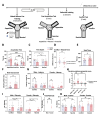Ventral hippocampus to nucleus accumbens shell circuit regulates approach decisions during motivational conflict
- PMID: 39854559
- PMCID: PMC11761569
- DOI: 10.1371/journal.pbio.3002722
Ventral hippocampus to nucleus accumbens shell circuit regulates approach decisions during motivational conflict
Abstract
Successful resolution of approach-avoidance conflict (AAC) is fundamentally important for survival, and its dysregulation is a hallmark of many neuropsychiatric disorders, and yet the underlying neural circuit mechanisms are not well elucidated. Converging human and animal research has implicated the anterior/ventral hippocampus (vHPC) as a key node in arbitrating AAC in a region-specific manner. In this study, we sought to target the vHPC CA1 projection pathway to the nucleus accumbens (NAc) to delineate its contribution to AAC decision-making, particularly in the arbitration of learned reward and punishment signals, as well as innate signals. To this end, we used pathway-specific chemogenetics in male and female Long Evans rats to inhibit the NAc shell projecting vHPC CA1 neurons while rats underwent a test in which cues of positive and negative valence were presented concurrently to elicit AAC. Additional behavioral assays of social preference and memory, reward and punishment cue processing, anxiety, and novelty processing were administered to further interrogate the conditions under which the vCA1-NAc shell pathway is recruited. Chemogenetic inhibition of the vCA1-NAc shell circuit resulted in animals exhibiting increased decision-making time and avoidance bias specifically in the face of motivational conflict, as the same behavioral phenotype was absent in separate conditioned cue preference and avoidance tests. vCA1-NAc shell inhibition also led to a reduction in seeking social interaction with a novel rat but did not alter anxiety-like behaviors. The vCA1-NAc shell circuit is therefore critically engaged in biasing decisions to approach in the face of social novelty and approach-avoidance conflict. Dysregulation of this circuit could lead to the precipitation of addictive behaviors in substance abuse, or maladaptive avoidance in situations of approach-avoidance conflict.
Copyright: © 2025 Patterson et al. This is an open access article distributed under the terms of the Creative Commons Attribution License, which permits unrestricted use, distribution, and reproduction in any medium, provided the original author and source are credited.
Conflict of interest statement
The authors have declared that no competing interests exist.
Figures




References
-
- Lewin K. The Conflict Between Aristotelian and Galileian Modes of Thought in Contemporary Psychology. J Gen Psychol. 1931;5:141–177.
-
- Miller N. Experimental studies of conflict. In: Hunt J, editor. Personality and the Behavior Disorders. Ronald Press; 1944. p 431–465.
-
- Fricke K, Vogel S. How interindividual differences shape approach-avoidance behavior: Relating self-report and diagnostic measures of interindividual differences to behavioral measurements of approach and avoidance. Neurosci Biobehav Rev. 2020;111:30–56. doi: 10.1016/j.neubiorev.2020.01.008 - DOI - PubMed
MeSH terms
LinkOut - more resources
Full Text Sources
Miscellaneous

